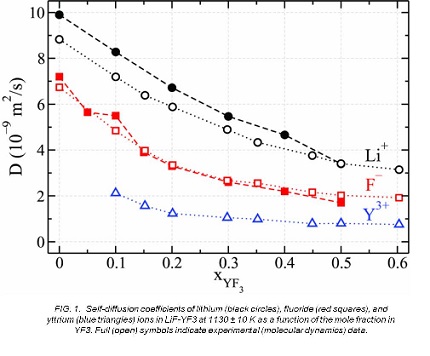Ask for a reprint
email :
* Give your email
2013
ACL
|
M.Levesque, V.Sarou-Kanian, M.Salanne, M.Gobet, H.Groult, C.Bessada, P.A.Madden, A.L.Rollet, 'Structure and dynamics in yttrium-based molten rare earth alkali fluorides', J. Chem. Phys. 138 184503 (2013) doi:10.1063/1.4802986
The transport properties of molten LiF-YF3 mixtures have been studied by pulsed field gradient nuclear magnetic resonance spectroscopy, potentiometric experiments, and molecular dynamics simulations. The calculated diffusion coefficients and electric conductivities compare very well with the measurements across a wide composition range. We then extract static (radial distribution functions, coordination numbers distributions) and dynamic (cage correlation functions) quantities from the simulations. Then, we discuss the interplay between the microscopic structure of the molten salts and their dynamic properties. It is often considered that variations in the diffusion coefficient of the anions are mainly driven by the evolution of its coordination with the metallic ion (Y3+ here). We compare this system with fluorozirconate melts and demonstrate that the coordination number is a poor indicator of the evolution of the diffusion coefficient. Instead, we propose to use the ionic bonds lifetime. We show that the weak Y-F ionic bonds in LiF-YF3 do not induce the expected tendency of the fluoride diffusion coefficient to converge toward the one of yttrium cation when the content in YF3 increases. Implications on the validity of Nernst-Einstein relation for estimating the electrical conductivity are discussed.
|

|